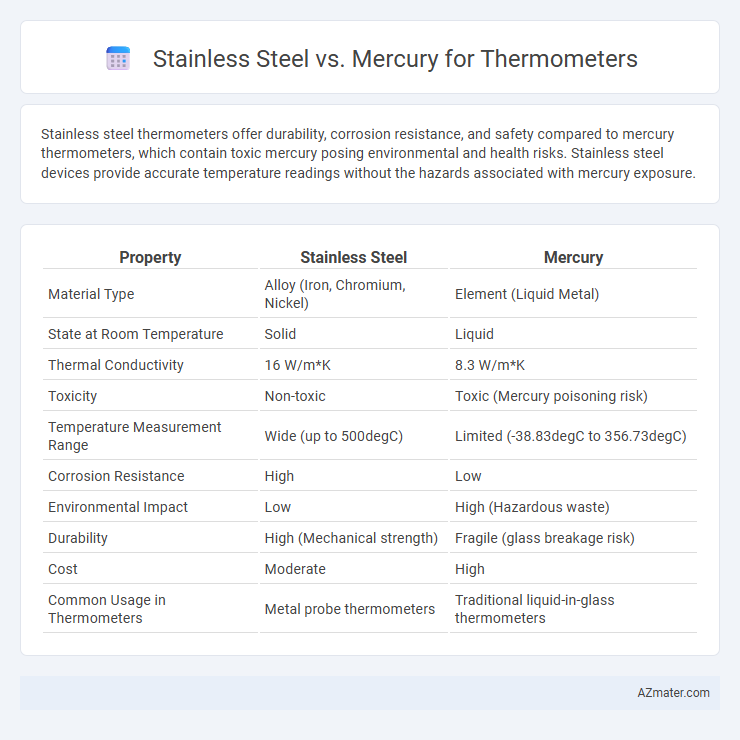Stainless steel thermometers offer durability, corrosion resistance, and safety compared to mercury thermometers, which contain toxic mercury posing environmental and health risks. Stainless steel devices provide accurate temperature readings without the hazards associated with mercury exposure.
Table of Comparison
| Property | Stainless Steel | Mercury |
|---|---|---|
| Material Type | Alloy (Iron, Chromium, Nickel) | Element (Liquid Metal) |
| State at Room Temperature | Solid | Liquid |
| Thermal Conductivity | 16 W/m*K | 8.3 W/m*K |
| Toxicity | Non-toxic | Toxic (Mercury poisoning risk) |
| Temperature Measurement Range | Wide (up to 500degC) | Limited (-38.83degC to 356.73degC) |
| Corrosion Resistance | High | Low |
| Environmental Impact | Low | High (Hazardous waste) |
| Durability | High (Mechanical strength) | Fragile (glass breakage risk) |
| Cost | Moderate | High |
| Common Usage in Thermometers | Metal probe thermometers | Traditional liquid-in-glass thermometers |
Introduction to Thermometer Materials
Thermometer materials significantly influence accuracy, durability, and safety, with stainless steel and mercury being two prominent options. Stainless steel offers corrosion resistance, mechanical strength, and is non-toxic, making it ideal for modern thermometers in medical and industrial applications. Mercury, historically favored for its uniform thermal expansion and high density, is now less common due to toxicity concerns and environmental regulations.
Key Properties of Stainless Steel Thermometers
Stainless steel thermometers offer superior corrosion resistance, durability, and safety compared to mercury thermometers, making them ideal for food processing and medical applications. Their quick response time and accurate temperature readings ensure reliable performance in various environments, while resistance to breakage eliminates the toxic risks associated with mercury. The non-toxic, eco-friendly nature of stainless steel also enhances sustainability and regulatory compliance in temperature measurement tasks.
Key Properties of Mercury Thermometers
Mercury thermometers exhibit exceptional thermal expansion properties, providing highly accurate temperature readings due to mercury's consistent volumetric response to temperature changes. Mercury's high boiling point (357degC) and low freezing point (-39degC) ensure reliable function across a wide temperature range without phase changes. Its dense, shiny liquid form enhances visibility within the glass tube, facilitating precise measurements in clinical and scientific applications.
Accuracy Comparison: Stainless Steel vs Mercury
Mercury thermometers offer superior precision due to mercury's consistent thermal expansion and stable temperature readings, making them highly reliable for accurate measurements. Stainless steel thermometers, while more durable and safer, may exhibit slight inaccuracies because metal sensors can be affected by external factors such as ambient temperature and sensor calibration. For applications requiring exact temperature readings, mercury thermometers maintain an edge in accuracy over stainless steel alternatives.
Safety and Toxicity Differences
Stainless steel thermometers offer superior safety compared to mercury thermometers due to their non-toxic, corrosion-resistant properties and durable construction, eliminating the risk of mercury poisoning if broken. Mercury thermometers contain elemental mercury, a toxic heavy metal that poses significant health hazards through inhalation or skin exposure, necessitating careful handling and disposal. The shift toward stainless steel thermometers is driven by environmental regulations and the need to minimize mercury-related toxicity risks in healthcare and household settings.
Environmental Impact of Both Materials
Stainless steel thermometers offer a significantly lower environmental impact compared to mercury thermometers due to stainless steel's recyclability and inert nature, which prevents soil and water contamination. Mercury is a toxic heavy metal that can accumulate in ecosystems, pose serious health risks, and requires specialized disposal methods to prevent environmental pollution. Transitioning to stainless steel thermometers reduces hazardous waste and supports sustainable practices in temperature measurement.
Durability and Lifespan Analysis
Stainless steel thermometers offer superior durability compared to mercury thermometers due to their resistance to corrosion, impact, and temperature fluctuations, ensuring a longer lifespan in various environments. Mercury thermometers, while accurate, are prone to breakage and toxicity risks, limiting their long-term usability and safety in both medical and industrial applications. The corrosion-resistant properties and robust construction of stainless steel models make them a more reliable choice for sustained, safe performance over time.
Application Suitability by Industry
Stainless steel thermometers offer excellent chemical resistance and durability, making them ideal for food processing, pharmaceuticals, and chemical manufacturing industries where contamination and corrosion resistance are critical. Mercury thermometers, while highly accurate for laboratory and industrial temperature measurements, pose safety and environmental risks that limit their use in healthcare and food industries. Stainless steel's robustness and non-toxic properties make it more suitable for applications involving frequent handling and stringent hygiene standards.
Regulatory Standards: Mercury vs Stainless Steel
Regulatory standards for thermometers heavily favor stainless steel due to mercury's toxicity and environmental hazards, leading to strict restrictions or bans in many countries under frameworks such as the Minamata Convention on Mercury. Stainless steel thermometers comply with safety and environmental regulations like RoHS and REACH, ensuring non-toxic, recyclable, and durable alternatives for medical, industrial, and laboratory use. Compliance with these standards makes stainless steel thermometers the preferred choice in global markets, aligning with public health policies and sustainability goals.
Future Trends in Thermometer Technologies
Stainless steel thermometers are gaining prominence due to their durability, corrosion resistance, and eco-friendly nature, aligning with stricter environmental regulations phasing out mercury usage. Innovations in non-toxic, stainless steel-based sensors integrated with digital interfaces enhance precision and user safety, driving market adoption. Future trends indicate a shift towards hybrid thermometers combining stainless steel's robustness with advanced digital technologies for real-time monitoring and connectivity in medical and industrial applications.

Infographic: Stainless steel vs Mercury for Thermometer
 azmater.com
azmater.com